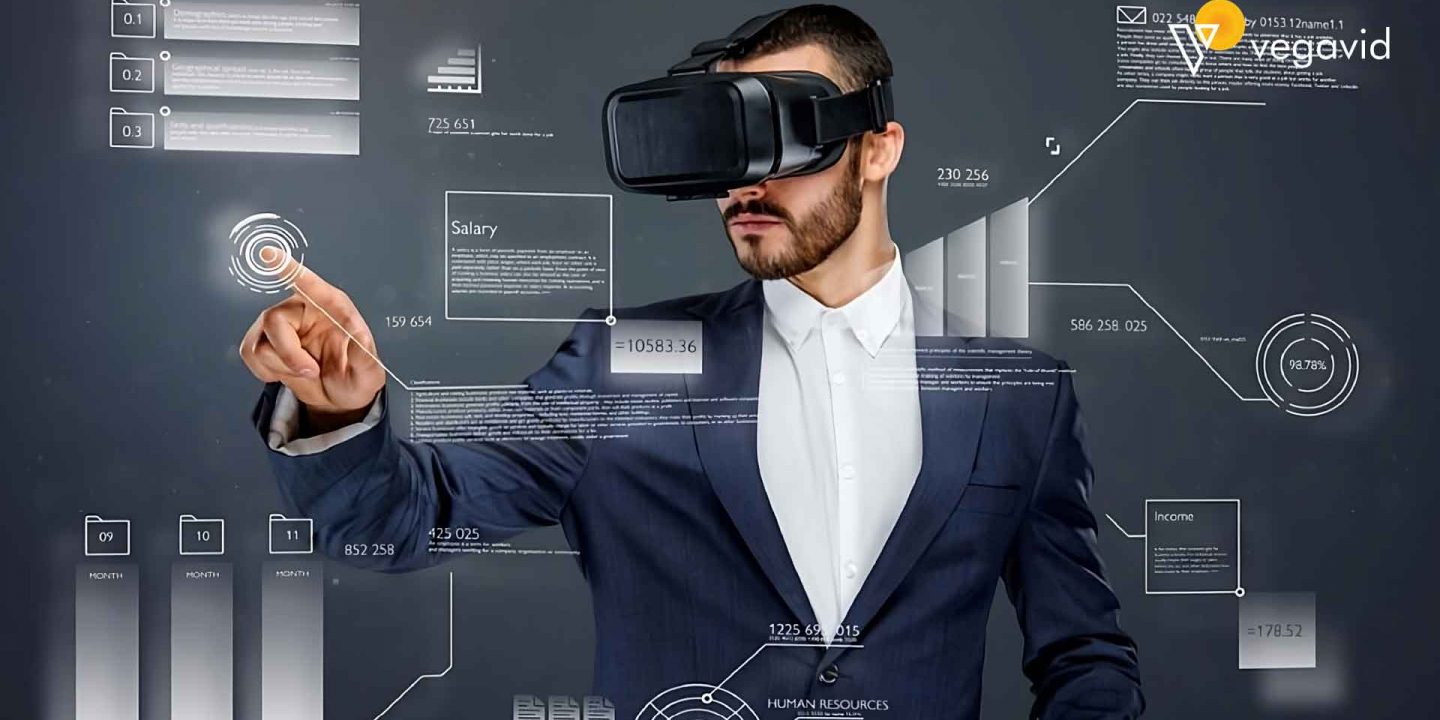
Augmented reality technologies are opening up many possibilities to improve operations for companies in the energy and utilities sector. AR supplements the real world with computer-generated info to provide benefits like improved work efficiency, safety, and productivity. While AR offers much potential, utility companies must weigh costs and risks against benefits, establish policies to mitigate issues and ensure technologies meet specific needs for successful implementation. When done right, however, augmented reality has the power to truly transform how energy utilities perform many essential tasks to deliver reliable power services.
What is Augmented Reality?
Augmented reality or AR is a technology that superimposes a computer-generated image on a user’s view of the real world, thus enhancing one’s perception of reality. Through the screen of a smartphone or special AR glasses, users can see digital objects overlaid in the real world in real-time.
AR uses technologies like cameras, displays, sensors, and software to add virtual elements to the physical environment that naturally interact with the real world. Popular AR apps allow users to place digital objects and animations into real environments and interact with virtual content that coexists with the real world.
For example, an AR app can superimpose digital dinosaurs or monsters into a camera view of a living room, make tangible products appear lifelike through a device screen, or enable workers to see virtual assembly instructions overlaid on physical parts. IKEA even offers an app allowing customers to visualize what furniture would look like in their homes using AR technology.
Benefits of using AR in energy and utilities
Augmented reality or AR can provide many benefits for companies in the energy and utilities sector, especially those involved in power generation, transmission, and distribution. Some key ways AR can help are:
- Remote assistance. AR glasses can allow field technicians to get live step-by-step instructions and visual support from experts to solve issues quickly. Experts can see what the technician sees and point out specific parts or issues.
- Worker training. AR simulations can enable safer and more hands-on training of workers on complex equipment and processes. Trainees gain experience interacting with virtual replicas of power stations, substations, and other facilities before working with real systems.
- Asset management. AR applications can provide digital overlays of utility assets like pipelines, cables, and circuitry to technicians as they maintain or repair them. This helps workers better understand asset configurations and detect issues efficiently.
- Safety improvement. Accident rates from human error, particularly line-of-sight issues, can reduce.
- Increased productivity. AR-assisted tasks take less time due to visualizations, real-time data, and remote expertise. Workers spend less time searching for information and make fewer errors are also minimized. Productivity gains of up to 30% are possible.
- Cost reduction. All the above benefits translate to cost savings for energy companies from less downtime, waste, and rework. There are also reductions in travel and training expenses with AR technology.
As AR devices become more affordable and capable, more utilities are likely to incorporate the technology into their operations.
Use cases
Augmented reality technologies are increasingly being applied in innovative ways within the energy and utilities industry. AR supplements the real world using digital elements to enhance workers’ experiences and productivity. Some of the key use cases of AR in this sector include-
Field Operations and Maintenance
One of the main applications of augmented reality in the energy and utilities sector is to assist field workers during operations and maintenance tasks. AR glasses or devices can provide many benefits in this context:
- Workers can see schematics and diagrams of power assets overlaid on the physical components they are maintaining. This helps them identify parts and connections faster with fewer errors.
- Remote experts can see what a field technician sees and provide live visualization-based instructions to troubleshoot complex issues. The expert can draw arrows, highlight parts and control the technician’s camera view.
- Fault detection algorithms run in the background to identify potential problems and issues that workers may miss. AR warnings draw attention to these defects in real time.
- Checklists and step-by-step guides are displayed as workers perform tasks to reduce human errors. They are automatically taken off the list as each step is completed.
- Safety hazards and risks are identified and highlighted to make workers aware of dangers during tasks. This reduces accidents due to poor visibility or line of sight.
Augmented reality can significantly improve the efficiency, accuracy, and safety of field operations and maintenance work in energy companies. Workers have access to real-time information, virtual annotations, and remote expertise that helps them do their jobs better with fewer mistakes. AR promises to revolutionize how utilities perform tasks critical to delivering reliable power services.
Asset Management and Monitoring
Another major application of augmented reality in the energy sector is to assist in managing and monitoring utility assets like power plants, substations, transmission lines, and pipelines. AR technologies can help in the following ways:
- Field technicians can see digital overlays of assets they are inspecting, from 3D models to circuit diagrams. This helps detect defects and issues that may be invisible to the naked eye.
- AR applications can superimpose the latest designs and schematics of assets over the physical structures for comparison.
- Workers performing routine checks can be guided step-by-step through the process using checklists and annotations displayed on AR devices. This ensures a thorough and accurate inspection.
- Remote experts can visualize what a field worker sees in real-time using AR lenses and annotate areas that need attention.
- AR sensing technologies like thermal imaging and vibration analysis can continuously monitor assets for abnormalities and deterioration.
Augmented reality holds great potential to transform asset management and monitoring in energy companies. Digital overlays, remote visualizations, automated checks, and real-time data help workers improve the reliability, lifespan, and performance of utility assets through more precise inspections and faster issue detection.
Safety and Emergency Response
Augmented reality technologies can significantly improve worker safety and emergency response for field crews in the energy and utilities sector. Some ways include:
- During routine maintenance and inspections, AR applications can identify and highlight potential hazards to workers in real-time.
- AR glasses can provide step-by-step safety checklists as tasks are performed to minimize human errors that cause accidents.
- In emergencies, field personnel can receive live guidance and visualizations from remote experts to handle the situation safely. Experts can see the environment through the AR device and draw annotations to guide worker actions.
- The exact locations of hazardous substances, gas leaks, and other potential dangers can be visually mapped and displayed for crews via their AR tools. This helps them avoid problem areas during response efforts.
- Practice simulations using AR re-creations of facilities, equipment, and hazardous scenarios can train workers on safely handling emergencies before they occur. Trainees interact with virtual risks.
In short, augmented reality offers many capabilities to make field jobs safer and emergency responses more effective in energy companies. Digital overlays, real-time alerts, remote guidance, and interactive simulations have the potential to significantly reduce accidents, minimize response times, and optimize worker safety.
Energy Infrastructure Planning and Design
Augmented reality technologies can also help energy companies in the planning and design of new infrastructure projects like power plants, substations, wind farms, and solar installations. Some applications include:
- AR applications can provide an interactive 3D visualization of infrastructure designs for stakeholders to review and give feedback before construction begins.
- Workers can experience virtual walkthroughs of planned facilities using AR devices to spot potential problems, bottlenecks, or safety hazards in designs before they are built. This improves designs.
- During construction, digital overlays of project designs can be superimposed on the physical work in progress using AR. Crews can ensure structures align accurately with the original plans in real-time.
- Complex systems like pipelines, circuitry, and machinery can be modeled and tested virtually using AR simulations before being built physically. This reduces design changes, rework, and delays.
- AR tools enable collaborators to spread across locations to visualize, annotate and manipulate the same virtual design plans together. Distance is no longer a barrier to real-time discussions and improvements.
Challenges and Considerations for Implementing AR in Energy and Utilities
While augmented reality offers many benefits for the energy and utilities sector, there are also challenges and considerations for successfully implementing AR technologies. Some of the key issues include:
- Costs – The upfront costs of AR hardware, software, maintenance, and training can be high. Companies must evaluate the return on investment to justify expenses.
- Security – As with all digital technologies, ensuring the security of AR systems, data, and networks from threats is important. Companies must establish appropriate security policies and controls.
- Reliability – AR applications and devices must be reliable enough for use in mission-critical operations. Any downtime or glitches can impact productivity and safety. High reliability is critical.
- Ergonomics – AR glasses and devices must be designed to minimize fatigue, eyestrain, and other potential ergonomic issues for field workers who use them for long periods. Comfort is essential.
- Training – Employees must be properly trained to use AR systems effectively without compromising safety or productivity. Training programs need to keep pace with technological changes.
- Connectivity – Many AR applications require constant internet connectivity which may be unreliable in remote locations where utility assets are located. Offline capabilities may be needed.
While augmented reality offers many operational benefits, energy companies must carefully evaluate technologies, address issues proactively, establish policies and safeguards to mitigate risks, and ensure AR systems meet specific needs and use cases. With proper planning and implementation, AR can significantly improve performance without disrupting workflows.
Conclusion
In summary, augmented reality is poised to change the way energy and utility companies operate through applications that enhance workers’ vision, provide real-time data and enable remote collaboration. Many functions from fieldwork to asset management to infrastructure planning stand to gain significantly from AR technologies. Though challenges exist, utilities that can harness the capabilities of augmented reality effectively have much to gain in terms of safety, productivity, and costs. With careful planning and the right use cases, AR promises to be a game changer for the energy industry in the coming years.










